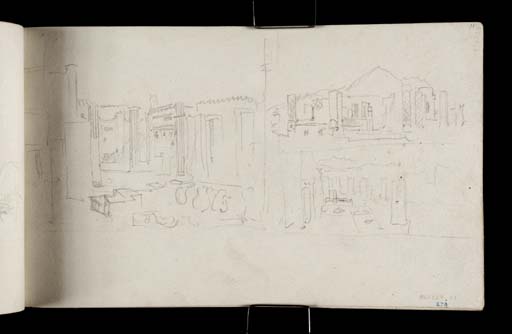Joseph Mallord William Turner Three Views of Pompeii, Including a Shop near the House of A. Cossius Libanus and the Interior of a Shop near the House of Pansa 1819
Image 1 of 2
-
 Joseph Mallord William Turner, Three Views of Pompeii, Including a Shop near the House of A. Cossius Libanus and the Interior of a Shop near the House of Pansa 1819
Joseph Mallord William Turner, Three Views of Pompeii, Including a Shop near the House of A. Cossius Libanus and the Interior of a Shop near the House of Pansa 1819 -
 Joseph Mallord William Turner, Three Views of Pompeii, Including a Shop near the House of A. Cossius Libanus and the Interior of a Shop near the House of Pansa 1819 (Enhanced image)Enhanced image
Joseph Mallord William Turner, Three Views of Pompeii, Including a Shop near the House of A. Cossius Libanus and the Interior of a Shop near the House of Pansa 1819 (Enhanced image)Enhanced image
Joseph Mallord William Turner,
Three Views of Pompeii, Including a Shop near the House of A. Cossius Libanus and the Interior of a Shop near the House of Pansa
1819
Joseph Mallord William Turner 1775–1851
Folio 11 Recto:
Three Views of Pompeii, Including a Shop near the House of A. Cossius Libanus and the Interior of a Shop near the House of Pansa 1819
D15757
Turner Bequest CLXXXV 11
Turner Bequest CLXXXV 11
Pencil on white wove paper, 113 x 189 mm
Inscribed by the artist in pencil ‘R’, ‘Blue | P’ and ‘G R Y R | B | Y’ within sketch on left and ‘R N [?Red]’ within sketch top right
Inscribed by ?John Ruskin in blue ink ‘278’ bottom right and ‘11’ top right
Stamped in black ‘CLXXXV 11’ bottom right
Inscribed by ?John Ruskin in blue ink ‘278’ bottom right and ‘11’ top right
Stamped in black ‘CLXXXV 11’ bottom right
Accepted by the nation as part of the Turner Bequest 1856
References
1909
A.J. Finberg, A Complete Inventory of the Drawings of the Turner Bequest, London 1909, vol.I, p.547, as ‘Ruins of a house’.
1984
Cecilia Powell, ‘Turner on Classic Ground: His Visits to Central and Southern Italy and Related Paintings and Drawings’, unpublished Ph.D thesis, Courtauld Institute of Art, University of London 1984, pp.186 note 74, 491 note 32.
1987
Cecilia Powell, Turner in the South: Rome, Naples, Florence, New Haven and London 1987, pp.79 note 25, [82] note 60.
During his sojourn in Naples in the autumn of 1819, Turner visited the famous archeological site of Pompeii. At this time the greatest part of the excavations could be found on the western side of the city and this page contains three sketches of different parts of the ruins.
Excavated between 1805 and 1809, the house of A. Cossius Libanus on the Via Consolare (commonly known as the Casa di Sallustio or House of Sallust, and occasionally as the House of Acteon) was one of the most recent and complete finds which Turner could have seen during his visit to Pompeii in 1819.1 The left-hand study represents a thermopolium or shop which stands adjacent to the house.2 Visible in the foreground is part of a marble counter with broken jars.3 See also the next-door bakery on folio 10 verso (D15756).
In the bottom right-hand corner is a study of the interior of the Taberna Fortunata, a shop serving hot and cold food which can be found at the junction of Via Consolare and Vicolo di Modesto. The view looks out across the shop’s marble counter with holes for amphorae and other vessels towards the back of the public fountain visible in folio 10 verso (D15756).4 The location of the subject in the top right-hand corner is not conclusively identified although it clearly depicts a view looking north across the ruins towards Vesuvius.
For further sketches and a general discussion of Turner’s visit to Pompeii see the introduction to the sketchbook.
Nicola Moorby
September 2010
The house was damaged by bombing during the Second World War and in 1970 underwent restoration to a more complete state so that it now looks very different from how Turner would have seen it.
The composition is identical to the plate after an 1817 drawing by Major James Cockburn, ‘Interior of an Oil Shop with Broken Jars, Adjoining the House of Acteon’ in Pompeii, Illustrated with Picturesque Views, Engraved by W.B. Cooke, from the Original Drawings of Liet. Col. Cockburn, of the Royal Artillery, vol.II, London 1827, between pp.10–11.
How to cite
Nicola Moorby, ‘Three Views of Pompeii, Including a Shop near the House of A. Cossius Libanus and the Interior of a Shop near the House of Pansa 1819 by Joseph Mallord William Turner’, catalogue entry, September 2010, in David Blayney Brown (ed.), J.M.W. Turner: Sketchbooks, Drawings and Watercolours, Tate Research Publication, December 2012, https://www

